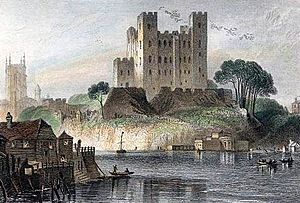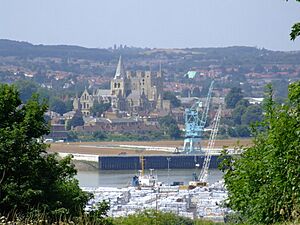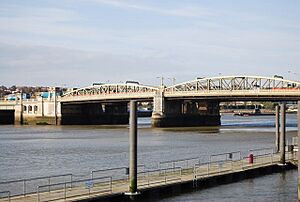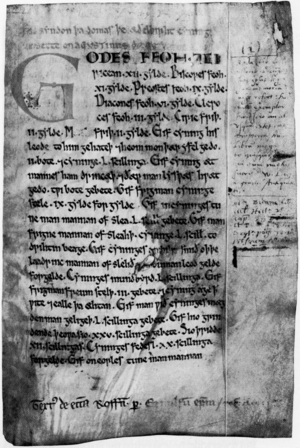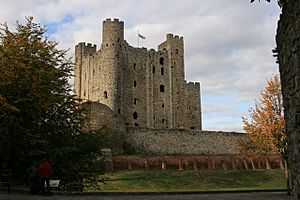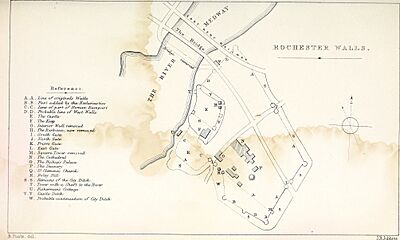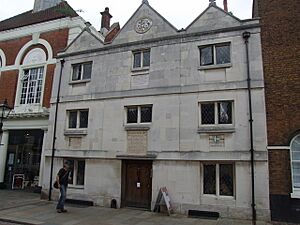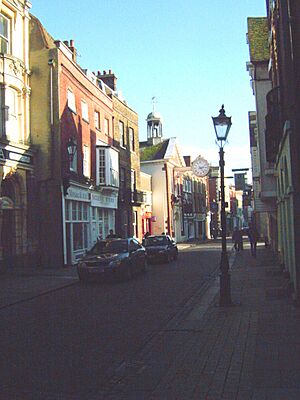History of Rochester, Kent facts for kids
Rochester is a historic town in Kent, England. It sits by the River Medway, about 48 kilometers (30 miles) from London. Its location was important because it was the lowest point where a bridge could cross the river. This bridge carried the famous Roman road, Watling Street, which is now the A2 road.
Contents
What's in a Name?
The name Rochester has a long history! The Romans called it Durobrivae. This name might mean "stronghold by the bridge" or "swift stream". It shows how important the river and any early forts were.
Later, around the year 730, a famous historian named Bede wrote about the town. He thought the name meant "Hrofi's fortified camp". This idea led to the name changing over time to Hrofæscæstre, then Rovescester, and finally, Rochester.
The word "chester" in Rochester comes from the Latin word castra, which means "fort" or "camp". Many English towns with "chester" in their name were once Roman camps, like Chester.
Rochester's Ancient History
Early Settlements
People lived in the Rochester area a very long time ago! We know this from ancient stone monuments called the Medway megaliths, like Kit's Coty House. These were built by people in the Stone Age.
Later, before the Romans arrived, the Belgae tribe lived here. They even made coins, which tells us Rochester was an important place for them.
Celtic Times
Rochester was one of the main towns for the Cantiaci tribe, a Celtic group in Britain. It was their western center, while their capital was in Canterbury. The ancient trackway that became Watling Street likely passed right through Rochester because of the best place to cross the Medway River.
Roman Rochester
The Romans arrived in Britain in AD 43. They fought a big battle at the Medway River, which was unusual because it lasted two days! After winning, they turned the Celtic town into a Roman settlement called Durobrivae.
The Romans built a bridge across the river exactly where the current bridge is today. They also built a wide path over the marshy ground on the Strood side of the river.
As things became more peaceful, Rochester grew. Its good transport links and fertile land made it a farming hub. Many Roman villas (large country houses) were built along the Medway valley. Around AD 190, the Romans built strong earth defenses, which were later replaced with stone walls in the 220s. Some of these stone walls can still be seen today!
In AD 407, the last Roman soldiers left Britain. This was a big change, but Roman culture continued for some time.
Medieval Rochester
Saxon Era
After the Romans left, the defenses of British kingdoms weakened. Around AD 449, the Jutes and Saxons arrived. They defeated the Britons and formed the Kingdom of Kent. Rochester became an important center in this new kingdom. By the early 600s, Rochester had a market and a port.
Around AD 600, King Ethelbert of Kent created a set of laws. These laws defined crimes and punishments. They were so important that they were written down over 500 years later in a book called the Textus Roffensis (the "Book of Rochester"). These laws are believed to be the oldest laws written in any Germanic language, and their words are the earliest surviving document in the English language!
In AD 604, Justus founded a cathedral in Rochester, becoming its first bishop. This showed how important the area was to the Roman mission from Canterbury. The first cathedral was dedicated to St. Andrew. A school was also started to train people for the church, which later became The King's School.
In AD 676, King Æthelred of Mercia attacked Kent and destroyed Rochester. The damage was so bad that the bishop at the time, Putta, left his position.
In AD 842, Danish invaders sacked Rochester. They besieged it again in AD 884, but the town held out until King Alfred came to help. By the 10th century, Rochester was allowed to mint its own coins. The wooden bridge is mentioned again in AD 960, and later, during Edward the Confessor's reign, local estates had a duty to help repair the bridge.
Norman Times
After William the Conqueror took over England in 1066, his half-brother Odo of Bayeux became the Earl of Kent. Odo gained a lot of land, including some that belonged to Rochester Cathedral. Later, this land was returned to the church. In 1077, Bishop Gundulf became Bishop of Rochester.
One of Gundulf's first actions was to start a hospital for the poor and sick. He also began rebuilding the cathedral in 1080, as it had become very old and run down. This new cathedral became the center of a Benedictine monastery and served as the bishop's main church.
Odo had built the first castle in Rochester in 1067. After a rebellion, the castle was briefly abandoned. But then, King William I asked Lanfranc and Gundulf to rebuild Rochester Castle on its current site. This first stone castle set the stage for the massive keep we see today.
In 1127, King Henry I gave Rochester Castle to the Archbishops of Canterbury. William de Corbeil, the first archbishop to own it, was responsible for building the famous large keep. This keep was so tall and impressive that it was even put on the town's official seal in the 1200s!
During the civil war known as The Anarchy (1135–1154), Rochester avoided direct fighting. However, the general lawlessness affected the town, and a third of its taxes were reduced because of the damage.
Later Middle Ages
In 1215, during a civil war, rebels took control of Rochester Castle. King John rode to Rochester and began a siege. His forces used siege engines and even dug under the castle walls. They filled the tunnels with pig fat and set it on fire, causing a part of the castle's great keep to collapse! The defenders finally gave up on November 30.
The cathedral was also being improved during this time. A new choir area was finished in 1227. In 1343, the central tower was raised, and four bells were hung there.
In 1264, another civil war broke out. Rochester Castle was held by supporters of Henry III. An army led by Simon de Montfort marched from London and attacked the town. They raided the cathedral and breached the castle's outer wall. The defenders retreated to the keep, but the siege was abandoned when a relief force arrived.
Rochester, like the rest of England, suffered from the plague in 1376. In 1381, the castle saw fighting for the last time during the Peasants' Revolt. Rebels captured and plundered the castle.
The old wooden bridge was falling apart by 1339. It became so dangerous that a ferry had to be used sometimes. In 1381, ice finally destroyed the old bridge. A new stone bridge opened in 1392 and lasted until the 1800s! The Rochester Bridge Trust was then set up to take care of the bridge.
In 1461, Edward IV gave Rochester a special charter. This recognized its loyalty and made the town a "city," with its own mayor.
Modern Rochester
Tudor and Stuart Times
Rochester played a part in the religious changes of the 1500s. John Fisher was Bishop of Rochester and was later executed by Henry VIII because he wouldn't agree to the king's divorce. He is now a Roman Catholic saint. Later, Nicholas Ridley was bishop and was executed by Queen Mary for his faith.
On New Year's Day 1540, Henry VIII met Anne of Cleves in Rochester. Later that year, the old monastery of St Andrew's was closed down as part of the Dissolution of the monasteries. The cathedral school was then re-established by Henry VIII and became "The King's School."
In 1579, Richard Watts died and left money to help the poor of Rochester. His will created the Richard Watts' Charity, which still exists today. The most famous part of his will provided a place for six poor travelers to stay overnight. They were given a bed and a small amount of money to help them on their way. This house closed to travelers in 1940 but continued as an almshouse.
In 1648, Rochester was involved in a Royalist uprising during the Second English Civil War. The Royalists destroyed part of Rochester Bridge as they retreated.
Rochester also saw two kings make important decisions. King Charles II stayed at a house in Crow Lane (now called Restoration House) the night before he was restored to the throne in 1660. This house is said to be the inspiration for Satis House in Charles Dickens's novel Great Expectations.
In 1667, during the Second Anglo-Dutch War, the Dutch navy launched a surprise raid. They broke through defenses and sailed to Rochester Bridge, capturing and burning English ships.

The Rochester Guildhall was built in 1687. It was partly paid for by Sir Joseph Williamson, a famous member of the Royal Society. The weather vane on top is a gilded model of an 18th-century ship.
Nearly 30 years after Charles II, King James II spent his last night as king in December 1688 at a house on the High Street, now known as Abdication House.
Georgian and Victorian Eras
The Corn Exchange, originally a butchers' market, was started in 1698. The clock on its front dates from 1771.
Sir Cloudesley Shovell also left money in his will (1701) to start the Mathematical School. This school taught navigation and math, especially useful for boys whose fathers worked at the nearby Chatham Naval Dockyard. It is now a grammar school for boys.
The bridge was widened between 1792 and 1822, but it still wasn't perfect. In 1839, a new design with fewer, wider arches was proposed. This new bridge opened in 1856. A railway bridge was built next to it at the same time.
In 1816, a young Charles Dickens moved to Rochester. Even though he only stayed a short time, he loved the area and later lived nearby at Gad's Hill. Many places in Rochester inspired his famous novels.
In 1850, Thomas Aveling started a business in Strood that became Aveling & Porter. They became the biggest makers of agricultural machines and steam rollers in the country. They made over 8,600 steam rollers!
The castle grounds were leased by the town in 1870 to create a park, and then bought outright in 1884. Today, English Heritage helps manage the castle.
In 1888, the Rochester Grammar School for Girls was founded, providing education for girls. On March 1, 1892, Rochester railway station opened, making it easier to travel to London.
20th and 21st Centuries
During the First World War, the Short Brothers aircraft company built planes near Rochester Castle. They made the first plane to launch a torpedo! Between the wars, they became famous for building flying boats like the Empire and Sunderland. During the Second World War, they designed and built the Stirling, one of the first four-engine bombers.
After the Second World War, the bridge was again too busy. In 1957, it was decided to convert an unused railway bridge into a road bridge. This new bridge opened in 1970. Now, the old bridge carries traffic going west, and the new bridge carries traffic going east.
In 1974, Rochester merged with Chatham and parts of Strood to form the District of Medway. This new district was later renamed the Borough of Rochester-upon-Medway. In 1982, the entire borough was granted city status, becoming the City of Rochester-upon-Medway.
The closure of the Chatham Dockyard in 1984 greatly impacted Rochester and its neighbors. Many jobs were lost, and the area had to adjust to a new economy. The former dockyard has since become the Chatham Historic Dockyard, a popular museum.
In 1998, the Medway Towns formed a new local government called the Medway unitary authority. However, due to an oversight, Rochester lost its city status. This error wasn't even noticed by the council for four years!


